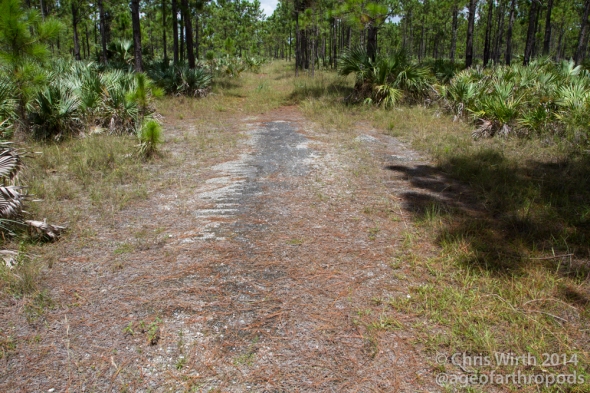Miami tiger beetle “endangered” status takes effect
Yesterday, November 4th 2016, endangered species status for the Miami tiger beetle (Cicindelidia floridana) became effective. This diminutive species is only found in pine rocklands, once ubiquitous in south Florida. However, due to extensive urbanization and agricultural development a majority of this habitat has been destroyed. Today a fraction – only 1.8% -of the pine rocklands in metro Miami-Dade county are left. The remaining pine rocklands have survived comparatively unscathed throughout the extensive agricultural and urban developments in south Florida. But the largest contiguous tract of pine rocklands in Miami-Dade, site of the Miami tiger beetle rediscovery, is in immediate danger of further development in the form of Coral Reef Commons, a private mixed-use development, and Miami Wilds, a sprawling theme park.
The remaining pine rocklands have survived comparatively unscathed throughout the extensive agricultural and urban developments in south Florida. But the largest contiguous tract of pine rocklands in Miami-Dade, site of the Miami tiger beetle rediscovery, is in immediate danger of further development in the form of Coral Reef Commons, a private mixed-use development, and Miami Wilds, a sprawling theme park.
Any further development will seriously jeopardize the rocklands and their inhabitants by severely fragmenting the habitat and stifling the cycle of bush fires key to the maintenance and survival of pine rocklands.
There are numerous, prime locations for a new Walmart or a massive theme park in the county, outside of these last remaining pine rocklands. Let’s restore and preserve the undeveloped and neglected pine rocklands of Miami-Dade; this habitat and its occupants are a unique and valuable part of Florida’s natural history and character.
The Miami tiger beetle receives “Endangered” status

The Miami tiger beetle, Cicindelidia floridana, and its story are unique. An 18-year-old student first collected the species in 1934 from pine rockland habitat in northern Miami-Dade. Pine rocklands were once the dominant habitat in south Florida, extending from the Florida Keys to the northern border of Miami-Dade County, but development has steadily engulfed this habitat. Today 1.8% of the metro Miami-Dade pine rocklands remain standing.
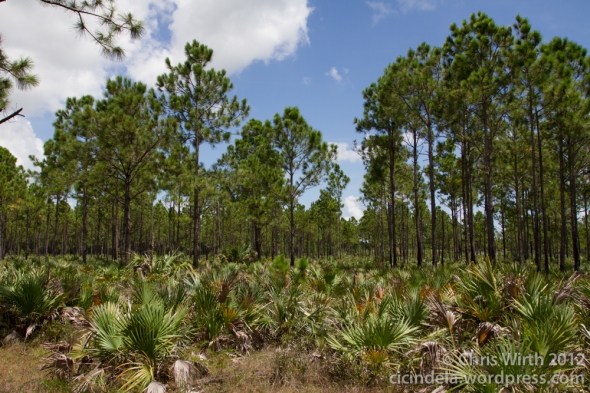
In the context of this widespread habitat loss and seventy years without any beetles observed the Miami tiger beetle was presumed extinct. But, in 2007 a population of Miami tiger beetles was rediscovered in the Richmond Heights pine rocklands, the largest contiguous remaining rocklands in Miami-Dade (below), and in 2015 a second population was found at an undisclosed patch of pine rocklands nearby.
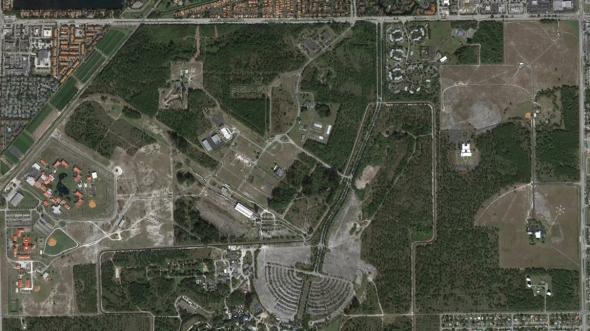
The Miami tiger beetle faces the immediate threats of habitat loss, degradation, and fragmentation from inadequate habitat management and two proposed developments; a mixed-use development, Coral Reef Commons (below) and a major theme park, Miami Wilds.
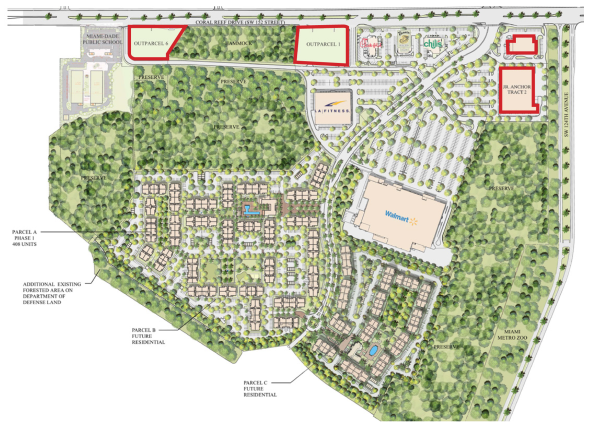
Distressingly, the species is also actively sought by private, non-scientist tiger beetle collectors due to its extreme rarity.
On December 11th 2014, the Center for Biological Diversity, Miami Blue Chapter of the North American Butterfly Association, South Florida Wildlands Association, Tropical Audubon Society, Sandy Koi, Al Sunshine, and I submitted a petition to U.S. Fish and Wildlife Service, urging the Miami tiger beetle be formally listed under the Endangered Species Act.
Today, on October 4th 2016, the Service announced the Miami Tiger Beetle will receive “endangered” status under the Endangered Species Act which will become effective on November 4th 2016.
The Miami tiger beetle joins other Federally listed (threatened and endangered) pine rockland endemics, including the Florida Bonneted bat (Eumops floridanus), Florida leafwing (Anaea troglodyta floridalis), Bartram’s hairstreak (Strymon acis bartrami), Blodgett’s silverbush (Argythamnia blodgettii), Florida brickell-bush (Brickellia mosieri), Big Pine partridge pea (Chamaecrista lineata var. keyensis), deltoid spurge (Chamaesyce deltoidea deltoidea), wedge spurge (Chamaesyce deltoidea serpyllum), Carter’s small-flowered flax (Linum carteri carteri), sand flax (Linum arenicola), and tiny polygala (Polygala smallii).
This species also joins other listed members of the Cicindelinae; there are two endangered tiger beetle species (Cicindela ohlone and Ellipsoptera nevadica lincolniana) and two threatened species (Ellipsoptera puritana and Habroscelimorpha dorsalis dorsalis).
However, no critical habitat has been proposed or designated at this time:
While the designation of critical habitat is prudent, the Service is delaying a proposed designation at this time and expects to complete work on it by September 30, 2017. In addition, there is a proposal to build two developments in the Richmond Pine Rocklands and the Service continues to work with developers.
It would appear that the interests of a few private individuals at Ram Realty and Miami Wilds LLC are taking precedence to the survival of the Miami tiger beetle, its fellow pine rockland endemic species, and the last 1.8% of the metro Miami-Dade pine rocklands. The publicly available plans released by the Coral Reef Commons and Miami Wilds developers show that un-surveyed pine rocklands and Miami-tiger-beetle occupied habitat, respectively, will be paved over and the stifling development will severely limit any management of the remaining habitat, chiefly by preventing controlled burns which pine rocklands and their inhabitants depend upon.
Despite this shortcomings, I sincerely thank the staff members of the South Florida Ecological Service. I’d also like recognize the efforts of my fellow Petitioners and extend my thanks.
Please stay tuned to this blog for updates on the Miami tiger beetle and its habitat.

References
Bousquet, Y. 2012. Catalogue of Geadephaga (Coleoptera, Adephaga) of America, north of Mexico. ZooKeys 245:1-1722.
Brzoska, D., C.B. Knisley, and J. Slotten. 2011. Rediscovery of Cicindela scabrosa floridana Cartwright (Coleoptera: Cicindelidae) and its elevation to species level. Insecta Mundi 0162:1-7.
Cartwright, O.L. 1939. Eleven new American Coleoptera (Scarabidae, Cicindelidae). Annals of the Entomological Society of America 32:353-364.
Center for Biological Diversity. 2016. Four Florida Plants Protected Under Endangered Species Act. Press Release. September 28, 2016
Florida Natural Areas Inventory (FNAI). 2010. Pine Rockland, in Guide to the natural communities of Florida: 2010 edition. Florida Natural Areas Inventory, Tallahassee, FL. 8 pp.
Knisley, C.B. 2008. Current status of the “Miami” tiger beetle. Final Report. October 28, 2008.
Knisley, C.B. 2011. Taxonomy, biology, and conservation of the Florida tiger beetle. Final Report to South Florida Ecological Services Office. February 20, 2011.
Knisley, C.B. 2013. Biological studies of the Florida tiger beetle, 2011-2013. Final Report. April 13, 2013.
Knisley, C.B. 2015. Species assessment of the Miami tiger beetle, Cicindelidia floridana. Revised Report. June 6, 2015.
Knisley, C., M. Kippenhan, and D. Brzoska. 2014. Conservation status of United States tiger beetles. Terrestrial Arthropod Reviews. 7: 93-145.
Natureserve 2016. NatureServe Explorer: An online encyclopedia of life. Version 7.0.
Pearson, D.L., C.B. Knisley, and C.J. Kazilek. 2006. A field guide to the tiger beetles of the United States and Canada: Identification, natural history and distribution of the Cicindelinae. Oxford University Press, New York.
Pearson, D.L., C.B. Knisley, D.P. Duran, and C.J. Kazilek. 2015. A field guide to the tiger beetles of the United States and Canada: Identification, natural history and distribution of the Cicindelinae. Second edition. Oxford University Press, New York.
U.S. Fish and Wildlife Service. South Florida Multi-Species Recovery Plan: Appendix C. Species of Concern and their Associated Community Types in South Florida.
URS Corporation, The Institute for Regional Conservation, and Muller and Associates, Inc. 2007. Miami Dade County Environmentally Endangered Lands Program Management Plan, Part II: Management of specific habitat types, Chapter 1: The pine rockland habitat. Submitted to Environmentally Endangered Lands Program, Miami, Florida by URS Corporation. K.A. Bradley, G.D. Gann, M.J. Barry, contributors.
USFWS Miami Tiger Beetle Hearing: Comments
Introduction:
On December 11th 2014, the Center for Biological Diversity, Miami Blue Chapter of the North American Butterfly Association, South Florida Wildlands Association, Tropical Audubon Society, Sandy Koi, Al Sunshine, and I (the Petitioners) submitted a petition to U.S. Fish and Wildlife Service (the Service), urging the Miami tiger beetle (MTB), Cicindelidia floridana, be formally listed under the Endangered Species Act.
A full year and seven days later, on December 18th 2015, the Service proposed “endangered” status for the MTB, and announced a “hearing for members of the general public to comment on that proposal in person,” as required by Section 4(b)(5) of the Endangered Species Act.
This public hearing was held on January 13, 2016 at Miami-Dade College’s Kendall campus and I flew in from Arizona to attend. I’ve already posted a brief synopsis, audio, and photos from the hearing and in this post I’m going to respond to “three” commenters.
USFWS Miami Tiger Beetle Public Hearing
With the December 2015 announcement by the U.S. Fish and Wildlife Service (Service) of proposed “endangered” status for the Miami tiger beetle (Cicindelidia floridana), a “hearing for members of the general public to comment on that proposal in person” was scheduled, as required by Section 4(b)(5) of the Endangered Species Act. This public hearing was held on January 13, 2016 at Miami-Dade College’s Kendall campus and I flew in from Arizona to attend. To listen to audio from the hearing click here or keep reading for my photos and some brief comments.
Shortly after 5pm I made my way across Miami-Dade College’s Kendall campus to their main auditorium. As I approached the auditorium entrance I saw half a dozen law enforcement officers monitoring the proceeding; two officers at a sign-in table next to the entrance, two at table on the opposite side, and, in between, two at the auditorium doors. Even inside the auditorium there was a USFWS Refuge officer at each entrance, further reinforcing the seriousness of this federal hearing.
Even through I was early there were over twenty people already present, both members of the public and Miami-Dade college students. As I waited for the start of the hearing I chatted with the USFWS officials present and picked up copies of their Miami tiger beetle factsheet and FAQ.
Prominently displayed were two posters depicting the historical and current (only 1.8% remains) pine rocklands in Miami-Dade county and the Richmond Heights pine rocklands, the primary habitat for the Miami tiger beetle. At a glance it is clear the drastic, almost complete, loss of pine rocklands within Miami-Dade county:
The hearing began with an informative presentation on the beetle and then the public comment period began. Among those speaking were myself, the lobbyist/head of Miami Wilds LLC, Paul Lambert, concerned citizens, and members of the Miami Pine Rocklands Coalition. I’ve included selected audio from the hearing below:
I will respond to Mr. Lambert/Miami Wild’s concerns and the ecologist’s comments in a second post. Additionally I’ll post my full comments to the Service in a separate post.
Please don’t forget the public comment period on USFWS’s proposal to list the Miami tiger beetle as endangered is still open (until February 22, 2016). To submit a comment to the Service go to the official site and click comment now.

(L-R) Sonya Thompson (Miami-Dade County), Chris Wirth (Cicindela blogger & Miami tiger beetle petitioner), Sandy Koi (Miami tiger beetle petitioner), Belén Valladares (Miami Pine Rocklands Coalition vice-president), Al Sunshine (Miami Pine Rocklands Coalition president & Miami tiger beetle petitioner).
Acknowledgements
I’d like to extend special thanks to Miami Pine Rocklands Coalition Vice-President Belén Valladares for providing transportation and lodging during my trip.
Ram Realty’s “Technical and Legal Submittal” and “Supplemental Response” to the Miami Tiger Beetle Emergency Listing Petition
In response to a December 11, 2014 emergency listing petition to protect the Miami tiger beetle (Cicindela floridana) filed by the Center for Biological Diversity, advocacy groups, and several individuals (myself included), Ram Realty retained the law firm Gunster, “Florida’s Law Firm for Business,” to craft their reply to the U.S. Fish and Wildlife Service (USFWS).
Luna E. Phillips is a “Florida Bar board certified Gunster shareholder who practices in the area of environmental, administrative and governmental law [and] leads the firm’s Environmental practice” (from Gunster’s website) wrote and submitted two responses to USFWS totaling some 7,500 words! However, in both of these documents there are serious systematic errors and fatal misunderstandings or, even worse, flagrant misrepresentation of the science. Below I’ve reproduced both of Ram’s filings in red and my comments in black.
Technical and Legal Submittal regarding the December 11, 2014 Emergency Listing Petition Filed by the Center for Biological Diversity, et al:
January 14, 2015
Dear Ms. Blackford:
As you know, this firm represents Coral Reef Retail LLC and Coral Reef Resi Ph I LLC, the owners of the Coral Reef Commons property (Coral Reef Owners). Enclosed is a Technical and Legal Submittal regarding the December 11, 2014 Emergency Listing Petition filed by the Center for Biological Diversity, et al. This Technical and Legal Submittal identifies the flaws in the emergency petition, and the Coral Reef Owners urge the US. Fish and Wildlife Service to carefully review before making a determination on the emergency petition.
The Coral Reef Owners respectfully request that this Technical and Legal Submittal be added to the administrative record for the Miami tiger beetle potential listing, and should the Service make any determinations on the emergency petition, Coral Reef Owners request to be notified. Please do not hesitate to contact me at – or via email – if you have any questions regarding the content of this letter.
Sincerely,
[Signed]
Luna E. Phillips
cc: Vicki Mott, US. Department of the Interior
Client [Ram Realty]
Rafe Petersen, Holland & Knight
Church Roberts, Johnson Engineering, Inc.
Proposed theme park “not located in an ideal location for tourism”
In an undergraduate thesis entitled “Zoo Miami Entertainment Area: Revitalization Through User Experience” University of Florida student Emilio Fuster laid out plans for a potential theme park adjoining Zoo Miami. However, he noted that there are several constraints this location, chiefly:
Despite its prestige, the site is not located in an ideal location for tourism. The main attractions of Miami (for the most part) all lie to the north, concentrated around Miami Beach. The immediate area is almost exclusively residential. Almost immediately surrounding the residential areas are large expanses of agricultural land with Homestead to the south being a large agricultural hub.
Overall the Zoo is not in an ideal location for tourism. Its location in proximity to other prominent areas of Miami and other attractions is quite remote. The area is also not a typical urban/pedestrian friendly one. Connections to the site are almost primarily vehicular. This severly (sic) limits connectability. Adding to this, the land uses of the areas do not add to its draw. Primarily residential, there is nothing but the Zoo and GCRM attracting visitors to the region.
As Fuster points out a theme park in this area, like 20th Century Fox’s Miami Wilds, would not be in close proximity to Miami’s main attractions – this will likely become a major issue for attendance.
Further compounding any development plans is the fact that the site is home to pine rocklands, a globally imperiled habitat, and the site is in an almost exclusively residential area. In the re-zoning, sale/transfer of land, and planning of Miami Wilds (and Coral Reef Commons) the public, especially the neighboring residents, were not – and still are not – included in the county’s and developers’ actions. This level of secrecy is unacceptable, particularly since the site of the development is home to pine rocklands and the planned development will be severely detrimental to the daily lives of the nearby residents.
Link to Fuster’s full thesis here
Once altered = gone forever?
With efforts to develop globally imperiled pine rocklands met with a public outcry, Ram Realty, developers of the planned Coral Reef Commons, have attempted to portray the Coral Reef Commons (CRC) pine rocklands as largely developed. While this is not true (only 12% of the CRC site is significantly developed), what happens when pine rocklands are altered? Is the site really no longer a place worth preserving as Ram suggests?

In the image above is one of the best maintained Richmond Heights pine rockland tracts, covering over 60 acres. Today it sits just outside of Zoo Miami (and in the footprint of Miami Wilds!) but in the 1940’s it was the site of Richmond Naval Air Station. Below in an image form 1952 you can see the expansive footprint of Richmond NAS.
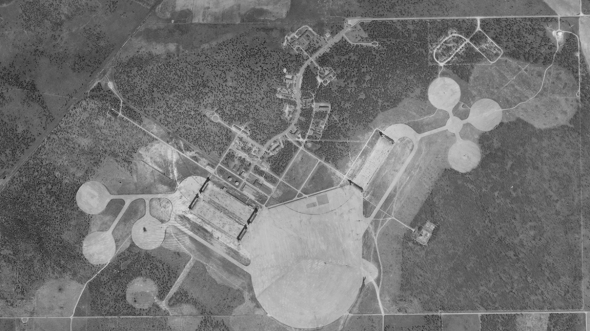
In this side-by-side view you can see the remnants of the blimp mooring pads and the red outline of this 60+ acre tract of rocklands in 1952 and in 2014. What today is a beautiful forest was tarmac, bare earth, and grass back in the 1950s. This land was originally pine rocklands but was cleared (in the early 1940s) to make way for the naval air station. But with the decommissioning of the Richmond NAS and subsequent period of unhindered growth (and semi-regular wildfires/prescribed burns) it is again beautiful pine rocklands. Most importantly this site is home of the rare Miami tiger beetle, a candidate for state and federal protection, along with numerous other endemic and rare animal and plants.
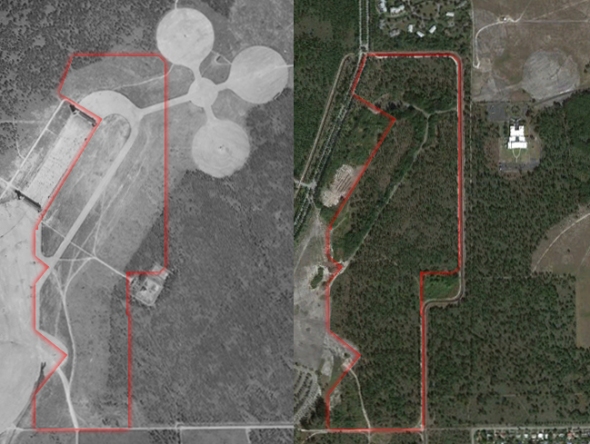
As you can see even pine rockland tracts which have been altered are excellent candidates for restoration and seriously in need of protection. This need is even more urgent for the remaining intact Richmond Heights pine rocklands, which sit in the footprints of Coral Reef Commons and Miami Wilds. Ram Realty and 20th Century Fox developers are still pushing forward on their Coral Reef Commons and Miami Wilds, respectively, and Miami-Dade county is trying to circumvent any environmental regulations protecting or pertaining to these pine rocklands by attempting to declare a massive swath of land around Zoo Miami as a “slum or blighted area.” These developments are both environmentally unacceptable and poorly planned, with no adequate measures taken to address the pine rocklands.
















